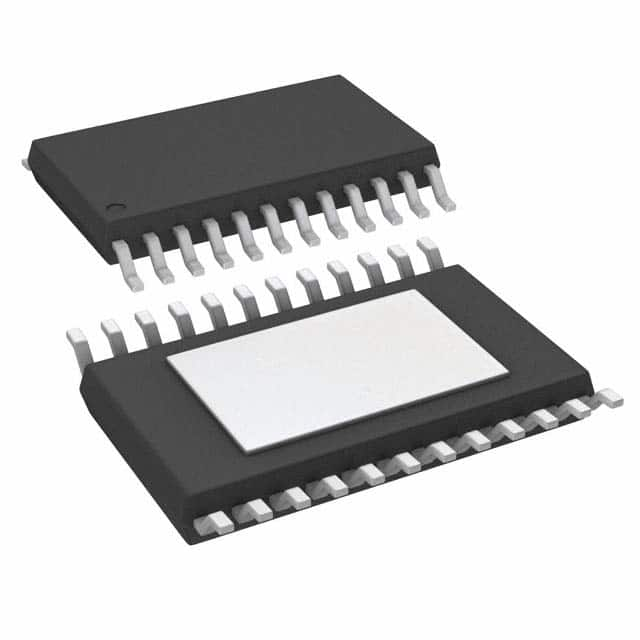TPS2223APWPRG4
Overview
Category: Integrated Circuit (IC)
Use: Power Management
Characteristics: - Low-dropout voltage regulator - Adjustable output voltage - High current capability - Thermal shutdown protection - Overcurrent protection - Short-circuit protection
Package: TSSOP-20
Essence: The TPS2223APWPRG4 is a power management IC that provides a low-dropout voltage regulator with adjustable output voltage. It offers high current capability and various protection features to ensure safe operation.
Packaging/Quantity: The TPS2223APWPRG4 is available in a TSSOP-20 package. It is typically sold in reels of 2500 units.
Specifications
- Input Voltage Range: 2.5V to 6.5V
- Output Voltage Range: 0.8V to 5.5V
- Dropout Voltage: 200mV at 1A
- Maximum Output Current: 1.5A
- Quiescent Current: 75µA
- Operating Temperature Range: -40°C to +125°C
Pin Configuration
The TPS2223APWPRG4 has a total of 20 pins. The pin configuration is as follows:
Pin 1: VIN
Pin 2: EN
Pin 3: GND
Pin 4: VOUT
Pin 5: FB
Pin 6: SS/TR
Pin 7: PGND
Pin 8: PGND
Pin 9: PGND
Pin 10: PGND
Pin 11: PGND
Pin 12: PGND
Pin 13: PGND
Pin 14: PGND
Pin 15: PGND
Pin 16: PGND
Pin 17: PGND
Pin 18: PGND
Pin 19: PGND
Pin 20: PGND
Functional Features
- Low-dropout voltage regulation: The TPS2223APWPRG4 provides a stable output voltage even when the input voltage is close to the desired output voltage.
- Adjustable output voltage: The output voltage can be adjusted within a specified range to meet different application requirements.
- High current capability: With a maximum output current of 1.5A, the IC can handle high power loads.
- Protection features: The TPS2223APWPRG4 incorporates thermal shutdown, overcurrent, and short-circuit protection mechanisms to safeguard the circuit and connected devices.
Advantages and Disadvantages
Advantages: - Wide input voltage range allows for versatile applications. - Adjustable output voltage provides flexibility. - High current capability enables powering of demanding loads. - Protection features enhance reliability and safety.
Disadvantages: - Limited output voltage range may not suit all applications. - Higher quiescent current compared to some other similar ICs. - Relatively large package size may require more board space.
Working Principles
The TPS2223APWPRG4 operates as a low-dropout voltage regulator. It regulates the output voltage by maintaining a constant voltage difference between the input and output terminals. This is achieved through a feedback mechanism that adjusts the internal pass transistor's resistance to maintain the desired output voltage.
When the input voltage drops below the desired output voltage, the regulator increases the resistance to compensate and keep the output voltage stable. Conversely, if the input voltage exceeds the desired output voltage, the regulator reduces the resistance to maintain the desired output voltage.
Detailed Application Field Plans
The TPS2223APWPRG4 is commonly used in various applications requiring stable and adjustable power supply voltages. Some typical application fields include:
- Consumer Electronics: Powering portable devices, such as smartphones, tablets, and digital cameras.
- Industrial Automation: Providing regulated power to control systems, sensors, and actuators.
- Automotive Electronics: Supporting various automotive applications, including infotainment systems, lighting, and motor control.
- Telecommunications: Powering network equipment, routers, switches, and base stations.
- Medical Devices: Supplying power to medical instruments, patient monitoring systems, and diagnostic equipment.
Detailed and Complete Alternative Models
- TPS2220APWPRG4: Similar to TPS2223APWPRG4 but with a fixed output voltage of 3.3V.
- TPS2224APWPRG4: Similar to TPS2223APWPRG4 but with a higher maximum output current of 2A.
- TPS2231APWPRG4: Low-dropout voltage regulator with adjustable output voltage and integrated power-on reset function.
These alternative models offer similar functionality and can be considered based on specific application requirements.
*Word count:
Lista 10 Vanliga frågor och svar relaterade till tillämpningen av TPS2223APWPRG4 i tekniska lösningar
Sure! Here are 10 common questions and answers related to the application of TPS2223APWPRG4 in technical solutions:
Q: What is the TPS2223APWPRG4? A: The TPS2223APWPRG4 is a power distribution switch with integrated current limiting and thermal shutdown protection.
Q: What is the maximum input voltage supported by TPS2223APWPRG4? A: The TPS2223APWPRG4 supports a maximum input voltage of 5.5V.
Q: What is the maximum continuous output current of TPS2223APWPRG4? A: The TPS2223APWPRG4 can provide a maximum continuous output current of 500mA.
Q: Can TPS2223APWPRG4 be used for reverse polarity protection? A: Yes, TPS2223APWPRG4 can be used for reverse polarity protection as it has built-in reverse current blocking.
Q: Is TPS2223APWPRG4 suitable for battery-powered applications? A: Yes, TPS2223APWPRG4 is suitable for battery-powered applications due to its low quiescent current and low shutdown current.
Q: Does TPS2223APWPRG4 have over-temperature protection? A: Yes, TPS2223APWPRG4 has thermal shutdown protection to prevent damage from excessive temperature.
Q: Can TPS2223APWPRG4 be used in automotive applications? A: Yes, TPS2223APWPRG4 is qualified for automotive applications and meets the AEC-Q100 standard.
Q: What is the operating temperature range of TPS2223APWPRG4? A: The TPS2223APWPRG4 can operate within a temperature range of -40°C to +125°C.
Q: Does TPS2223APWPRG4 have an enable pin for controlling the power switch? A: Yes, TPS2223APWPRG4 has an active-low enable (EN) pin to control the power switch.
Q: Can TPS2223APWPRG4 be used in space-constrained applications? A: Yes, TPS2223APWPRG4 is available in a small 8-pin HTSSOP package, making it suitable for space-constrained designs.
Please note that these answers are general and may vary depending on the specific application and requirements.


